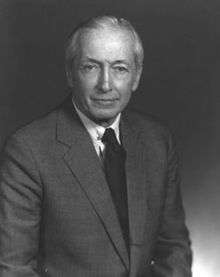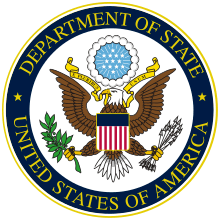Walter J. Stoessel Jr.
| Walter John Stoessel Jr. | |
|---|---|
 | |
| 7th United States Deputy Secretary of State | |
|
In office February 11, 1982 – September 22, 1982 | |
| President | Ronald Reagan |
| Preceded by | William P. Clark Jr. |
| Succeeded by | Kenneth W. Dam |
| United States Ambassador to Poland | |
|
In office 1968–1972 | |
| Preceded by | John A. Gronouski |
| Succeeded by | Richard T. Davies |
| United States Ambassador to the Soviet Union | |
|
In office 1974–1976 | |
| President | Gerald Ford |
| Preceded by | Jacob D. Beam |
| Succeeded by | Malcolm Toon |
| United States Ambassador to West Germany | |
|
In office 1976–1980 | |
| Preceded by | Martin J. Hillenbrand |
| Succeeded by | Arthur F. Burns |
| Personal details | |
| Born |
January 24, 1920 Manhattan, Kansas, U.S. |
| Died |
December 9, 1986 (aged 66) Washington, D.C. |
| Alma mater |
Stanford University Columbia University |
| Profession | Diplomat |
Walter John Stoessel Jr. (January 24, 1920 – December 9, 1986) was an American diplomat.
Life and career
Born in Manhattan, Kansas, Stoessel was the son of Katherine (Haston) and Walter John Stoessel Sr. and attended high school in California. The paternal side of his family had migrated to US from Western Germany in the middle of 19th century. He graduated from Stanford University in 1941 and later undertook graduate studies at Columbia University.
A career officer of the United States Foreign Service, Stoessel served as the U.S. ambassador to Poland from 1968 to 1972, U.S. Assistant Secretary of State for European and Canadian Affairs from 1972 to 1974, the U.S. ambassador to the Soviet Union between 1974 and 1976, and the ambassador to West Germany from 1976 through 1980. During his term as ambassador to Poland, Stoessel initiated contact with China and hosted talks on behalf of the United States, directly opening the door for President Richard Nixon's famous visit to China.[1] In 1981, while ambassador to West Germany, he joined the delegation, with Walter Mondale, greeting the U.S. hostages released by Iran when they deplaned.[2]
In 1982, President Ronald Reagan appointed Stoessel as the United States Deputy Secretary of State. During his term he served briefly as acting Secretary of State between the tenures of Alexander M. Haig and George P. Shultz.
He died in Washington, D.C. of leukemia[3] and is buried at Arlington National Cemetery. The U.S. Department of State awards a Walter J. Stoessel Award for Distinguished Diplomatic Service in his honor.
References
- ↑ "Model of an Ambassador; Walter John Stoessel Jr". The New York Times. January 21, 1970.
- ↑ John Vinocur (22 Jan 1981). "52 Former Hostages Start Readapting In U.S. Air Force Hospital in Germany". The New York Times.
- ↑ https://www.nytimes.com/1986/12/11/obituaries/walter-j-stoessel-jr-dies-at-66-a-former-ambassador-to-moscow.html
External links
| Government offices | ||
|---|---|---|
| Preceded by Martin J. Hillenbrand |
Assistant Secretary of State for European Affairs August 9, 1972 – January 7, 1974 |
Succeeded by Arthur A. Hartman |
| Diplomatic posts | ||
| Preceded by Jacob D. Beam |
United States Ambassador to the Soviet Union 1973–1976 |
Succeeded by Malcolm Toon |
| Preceded by Martin J. Hillenbrand |
United States Ambassador to Germany 1976–1981 |
Succeeded by Arthur F. Burns |
| Preceded by William P. Clark Jr. |
U.S. Deputy Secretary of State 1982 |
Succeeded by Kenneth W. Dam |
